About the competition
Now in its fifty-sixth year, the Wildlife Photographer of the Year (WPY) competition and exhibition showcases the beautiful wildlife of the Earth by talented photographers across the world. This year’s competition attracted almost 49,000 entries from professionals and amateurs across 86 countries.
Wildlife Photographer of the Year is developed and produced by the Natural History Museum, London (NHM). The competition was originally founded in 1965 by BBC Wildlife Magazine, then called Animals. The NHM joined forces in 1984 to create the competition as it is known today, and now solely runs and owns it.
The overall winners will be announced via the first ever virtual awards ceremony, streaming straight from the NHM on the evening of Tuesday 13 October. The exhibition at the NHM opens on Friday 16 October 2020.
The 2021 competition opens for entries on Monday 19 October and closes at 11.30am GMT on 10 December 2020. The competition is open to photographers of all ages and abilities. Find out more on the WPY website.
View the Winning and Highly Commended images from recent years:
To view the images as a slideshow, click on the arrows in the top right hand corner of the photos below.
Animal Portraits
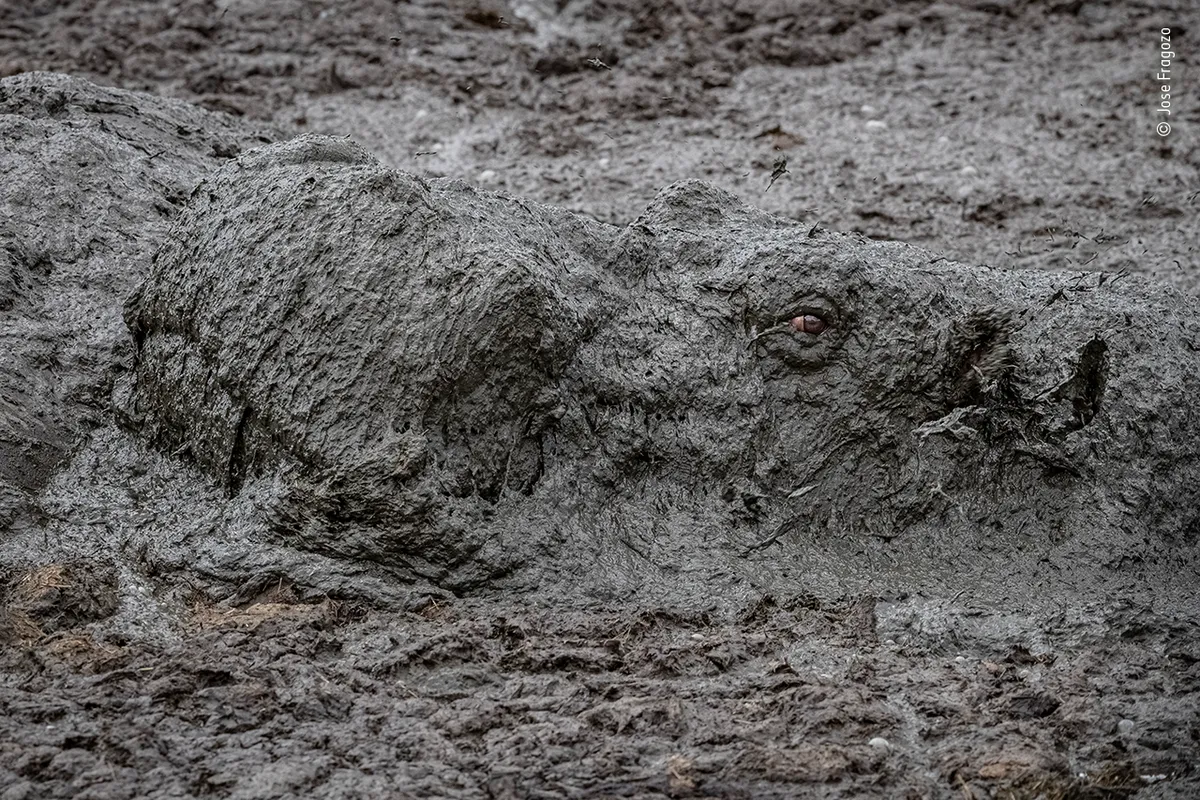
An eye blinks open in the mud pool as a hippopotamus emerges to take a breath – one every three to five minutes. The challenge for Jose, watching in his vehicle, was to catch the moment an eye opened. For several years, Jose has been watching hippos in Kenya’s Maasai Mara National Reserve – here in a remnant of the drought-stricken Mara River.
Hippos spend the day submerged to keep their temperature constant and their sensitive skin out of the sun, and at night they emerge to graze on the floodplains. Throughout their sub-Saharan African range, hippos are vulnerable to the combined effects of increasing water extraction and climate change. They are vital grassland and aquatic ecosystem engineers, and their dung provides important nutrients for fish, algae and insects. But when rivers run dry, a concentration of dung depletes the oxygen and kills the aquatic life.
Behaviour: Mammals
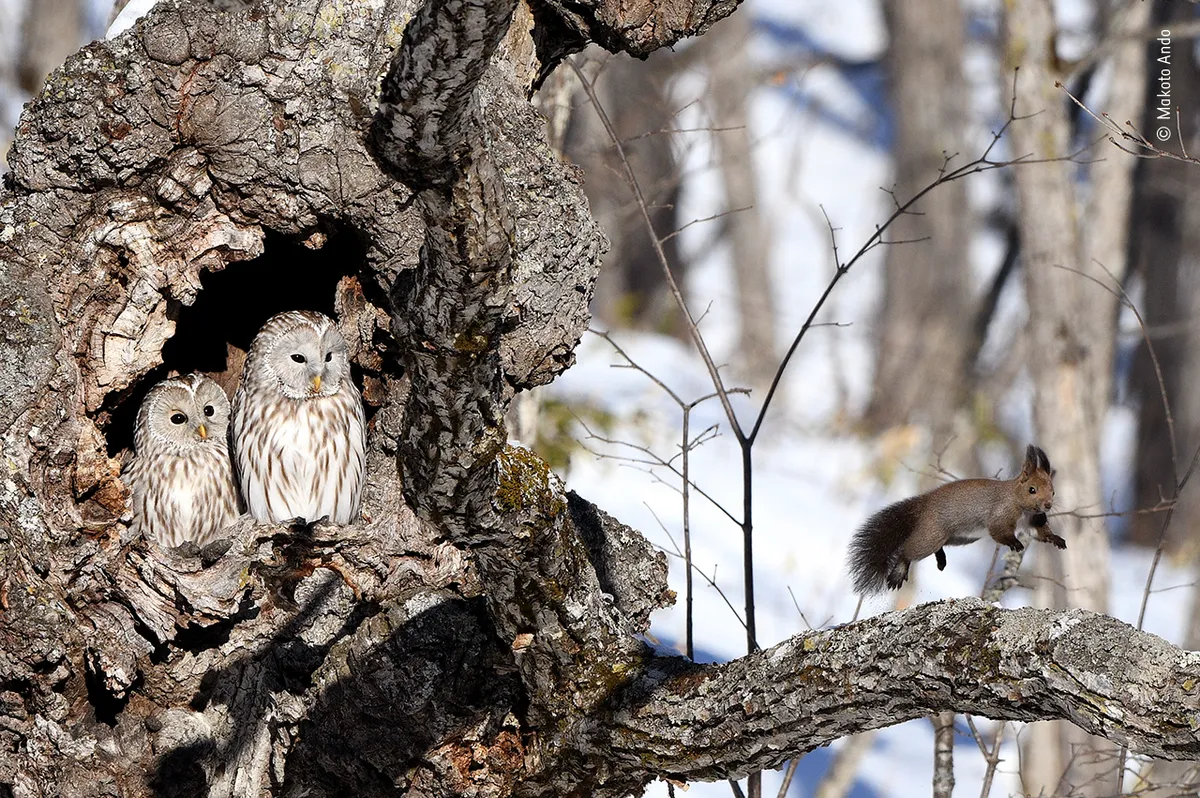
A red squirrel bounds away from its surprise discovery – a pair of Ural owls, very much awake. In forest near his village on the Japanese island of Hokkaido, Makoto had spent three hours, in freezing conditions, hiding behind a nearby tree hoping that the owl couple would pose or perform. Suddenly, a squirrel appeared from the treetops.
“It was extraordinary to see them all in the same tree,” says Makoto. Ural owls prey mainly on small mammals, including red squirrels. This one, with characteristic tufted ears, bushy tail and grey-tinged winter coat, is a subspecies of the Eurasian red squirrel endemic to Hokkaido (possibly threatened by the introduction of mainland red squirrels, originally as pets).
Rather than fleeing, the curious squirrel approached and peered into the owls’ hole, first from the top, then from the side. “I thought it was going to be caught right in front of me,” says Makoto, “but the owls just stared back.”
The curious squirrel, as if suddenly realizing its mistake, leapt onto the nearest branch and sped away into the forest. With equally quick reactions, Makoto managed to frame the whole story – the squirrel’s escape, the owls’ expression and a soft hint of the wintry forest landscape.
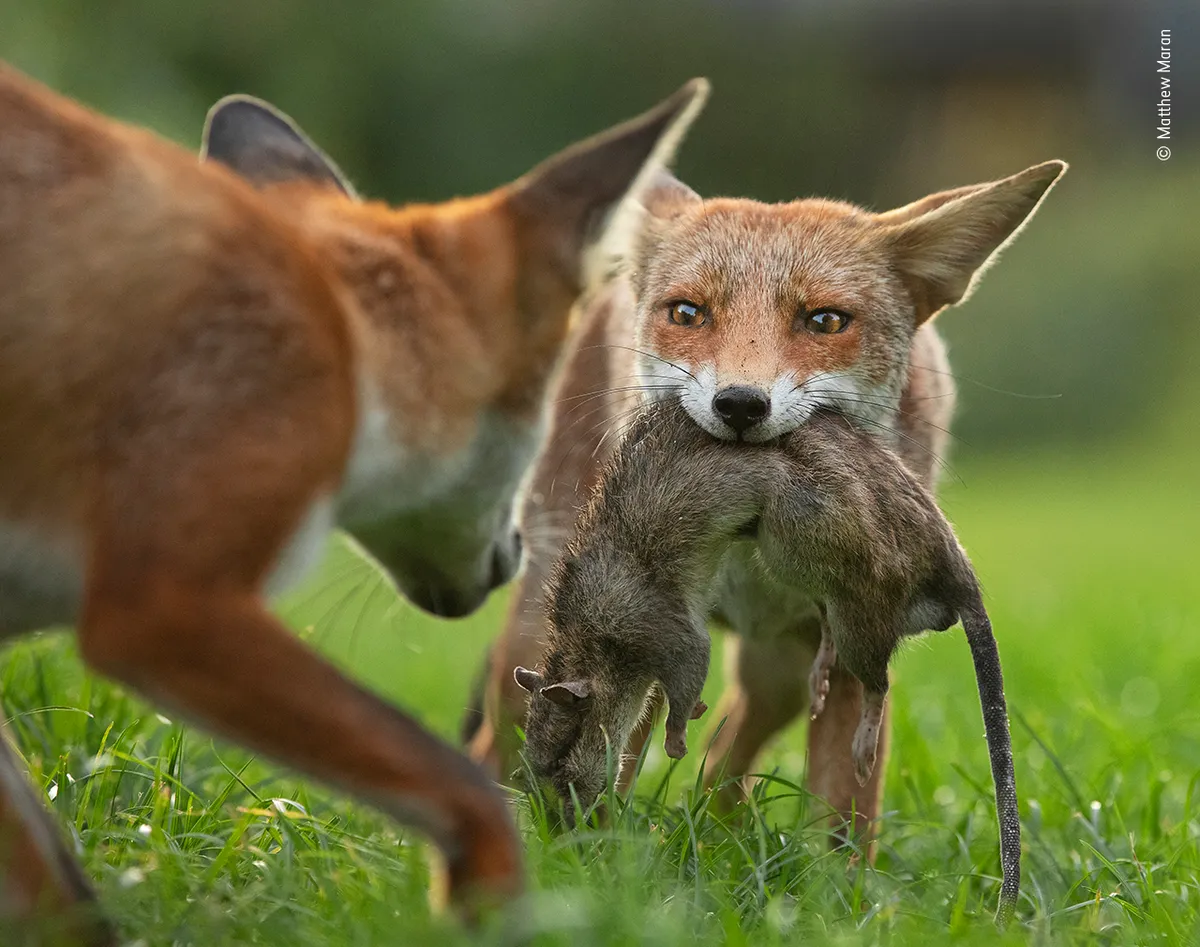
With a determined stare, a young fox holds tight to her trophy – a dead brown rat – as her brother attempts to take it off her. For the past four years, Matthew has been photographing the foxes that live on a North London allotment. Like all foxes, they are opportunistic, taking advantage of all available food, whether human or pet food discarded or put out by fox-lovers, fruit, mice, voles, worms and other invertebrates, even birdfood.
On this August evening, as Matthew lay prone watching the youngsters at play, one of them exploded out of the bushes with a dead rat in its mouth. The other three then began squabbling over it and a tug-of-war developed. When one got the prize, it would repeatedly toss it into the air and catch it. The rat could have been provided by one of the adults – which continue to feed their young into August – but it is rare for foxes to catch rats. More likely, it had been found dead.
With their long, narrow jaws and thin canines, foxes are designed to hunt small rodents in a ‘pounce and hold’ way. Young rats are possible prey – treated like mice and voles, tossed in the air and bitten to fracture the bones – but adult rats are formidable fighters, capable of inflicting serious injury to a fox’s face and eyes. If an adult rat is caught unawares, it will be held firm and shaken violently to maximize damage and avoid a counter-attack. Weak or dead rats, though, provide easy pickings, which makes foxes particularly vulnerable to poisoning by rodenticide.
Behaviour: Birds
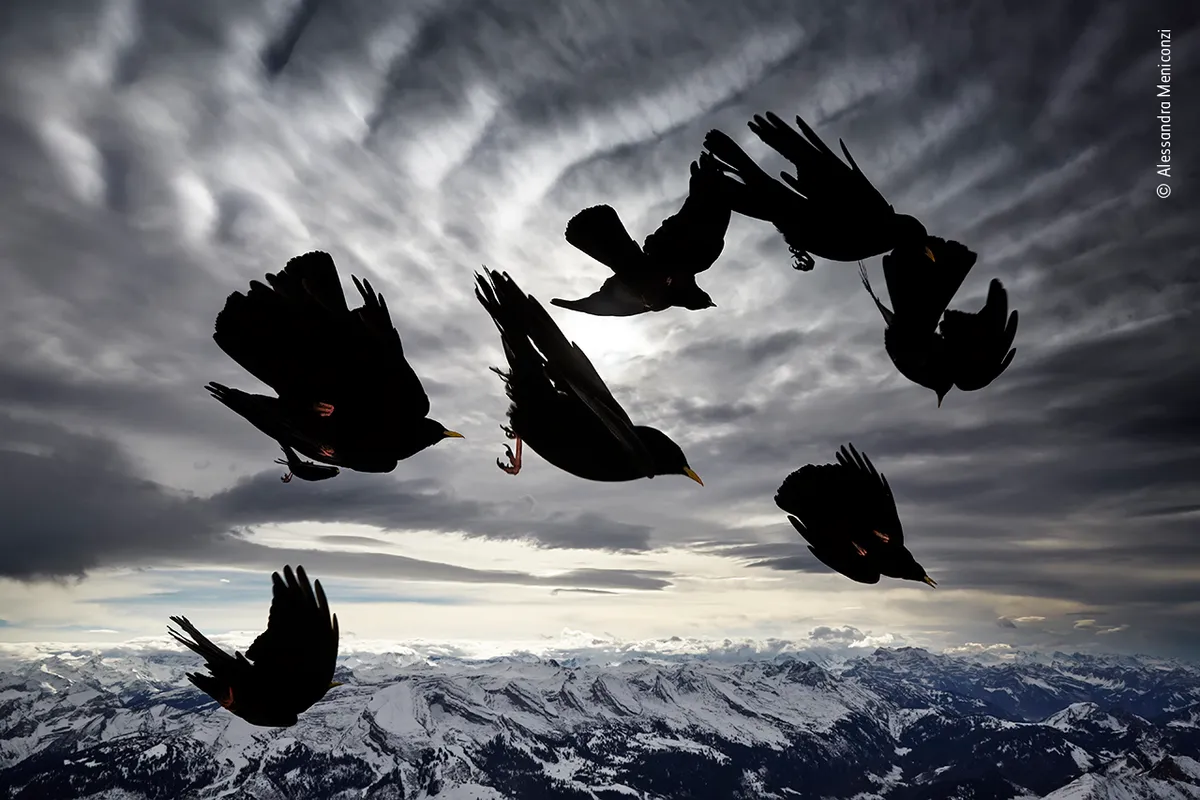
Blasted by the wind, high on the Alpstein Massif of the Swiss Alps, Alessandra could barely stand, but the yellow-billed choughs were in their element. These gregarious mountain birds nest in rocky ravines and on cliff faces, staying with their partners throughout the year.
They feed mostly on insects in summer, and berries, seeds and human food waste in winter – boldly scavenging in flocks around ski resorts. They are constantly on the move looking for food, and as a scavenging flock drew closer, Alessandra could hear them shrieking ‘so loud and insistent in the dramatic landscape – it was like being in a thriller movie’.
Taking advantage of gusts of wind sweeping the birds towards her and slowing their path, she captured their’ impressive acrobatics – one in characteristic headlong plunge – against the moody sky and jagged, snow-capped mountains. Red feet and yellow bills accent the monochrome of her atmospheric picture.
Behaviour: Amphibians and Reptiles
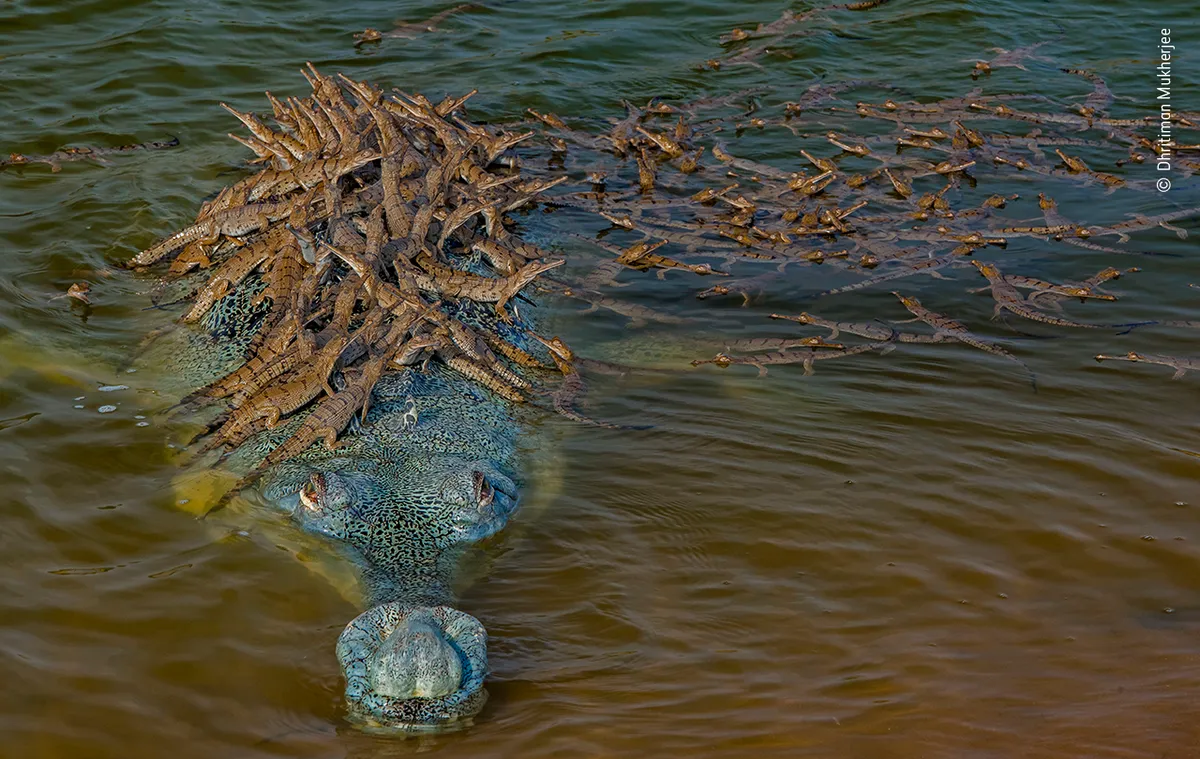
Ever watchful, a large male gharial – at least 4 metres (13 feet) long – provides solid support for his numerous offspring. It is breeding season in the National Chambal Sanctuary in Uttar Pradesh, northern India, and this usually shy reptile now exudes confidence. Its name comes from the bulbous growth at the tip of a mature male’s long thin snout (‘ghara’ is a round pot in Hindi), believed to be used to enhance sounds and underwater bubble displays made during breeding.
Though numbers might have once exceeded 20,000, spread across South Asia, the past century saw drastic declines. The species is now critically endangered – an estimated 650 adults are left, about 500 of them living in the sanctuary. They are threatened mainly by the damming and diversion of rivers and extraction of sand from riverbanks where they nest, as well as the depletion of fish stocks and entanglement in nets.
A male will mate with seven or more females, who nest close together, their hatchlings aggregating into one large crèche. This male was left in sole charge of his month-old offspring, observes Dhritiman, but both sexes are known to care for their young. So as not to disturb the gharials, he spent many days quietly watching from the riverbank. His picture encapsulates at once the tenderness of a protective father and its ‘don’t mess with my offspring’ attitude.
Behaviour: Invertebrates
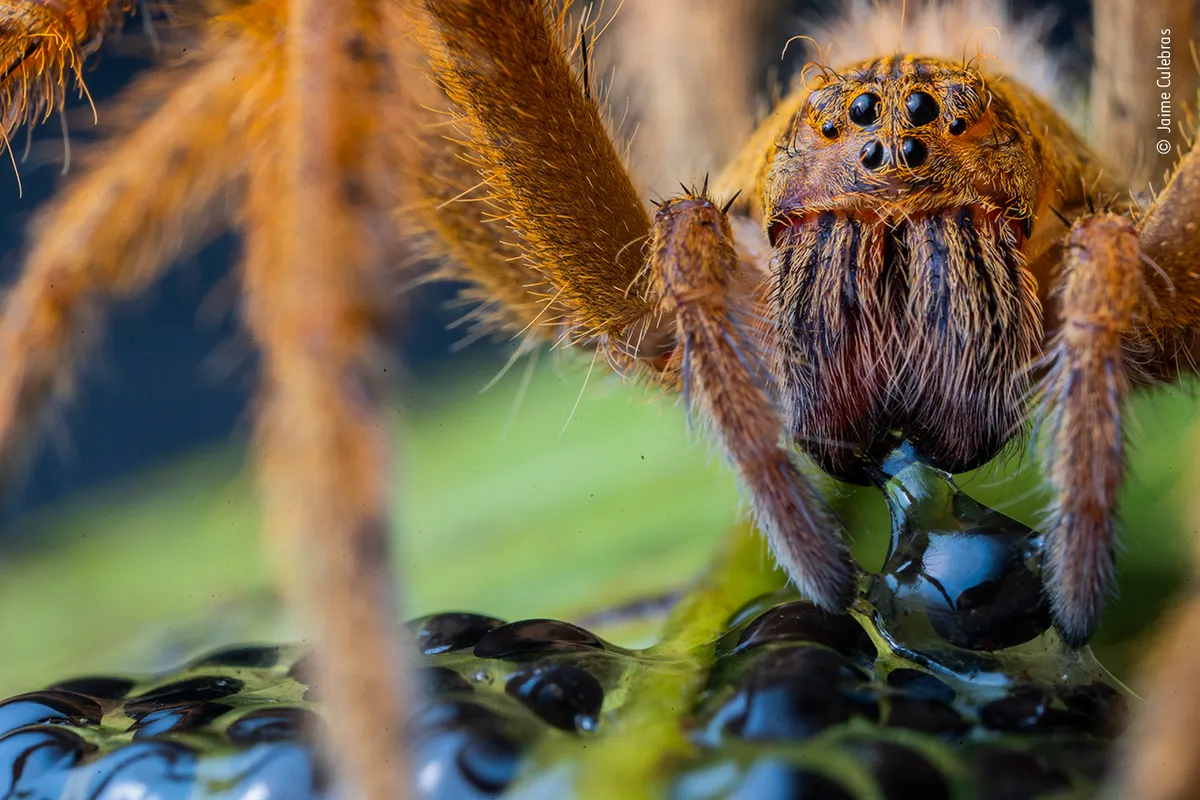
A large wandering spider – black, hooked fangs tipping its bristly, striped mouthparts – pierces the egg of a giant glass frog, injects digestive juices and then sucks in its liquefied prey. Jaime had walked for hours, in darkness and heavy rain, to reach the stream in Manduriacu Reserve, northwestern Ecuador, where he hoped to find glass frogs mating.
But his reward turned out to be a chance to photograph a behaviour he had seldom seen – a wandering spider with an 8-centimetre (3-inch) leg span devouring the frogs’ eggs. The 11 known species of wandering spiders are thought to be key predators of these small, often translucent amphibians. They shelter in rainforest plants in the day and hunt at night, usually by ambushing prey that ventures close enough.
Armed with sensitive bristles, the spider can detect vibrations transmitted through leaves and may also pick up sounds such as amphibians’ mating calls. Their battery of eight eyes, including two large ones on the side of the head, have differing functions and are highly sensitive to low light but are smaller than in spiders that actively pursue their prey.
Jaime set up his shot to capture the precise moment the female spider grasped the thin jelly coating between her fangs, steadying the egg with her long, hairy palps. One by one – over more than an hour – she ate the eggs.
Plants and Fungi
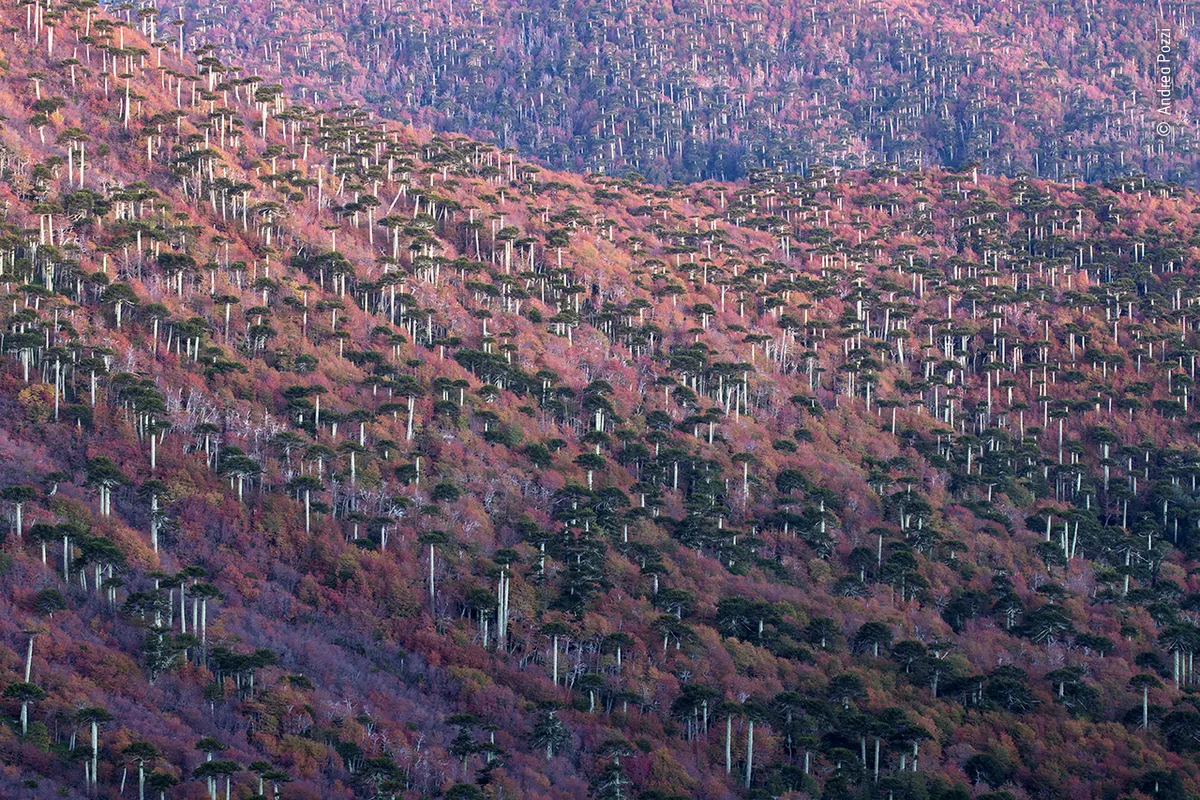
The Araucanía region of Chile is named after its Araucaria trees – here standing tall against a backdrop of late-autumn southern beech forest. Andrea had been enchanted by this sight a year previously and had timed his return to capture it. He hiked for hours to a ridge overlooking the forest and waited for the right light, just after sunset, to emphasize the colours. The trunks gleamed like pins scattered on the landscape, and he framed the composition to create the feeling that the whole world was clothed in this strange forest fabric.
Native to central and southern Chile and western Argentina, this Araucaria species was introduced to Europe in the late eighteenth century, where it was grown as a curiosity. Highly prized for its distinctive appearance, with whorls of spiky leaves around the angular branches and trunk, the tree acquired the English name monkey puzzle.
In its natural habitat, Araucaria forms extensive forests, often in association with southern beech and sometimes in pure stands on volcanic slopes. The ecology of these regions is shaped by dramatic disturbances, including volcanic eruptions and fires.
Araucaria withstands fires by having thick, protective bark and specially adapted buds, while southern beech – a pioneer – regenerates vigorously after fires. In such environs, Araucaria can grow to 50 metres (164 feet) tall, usually with branches restricted to the upper part of the tree – to reach the light over the broadleaf understorey – and can live for more than 1,000 years.
Under water
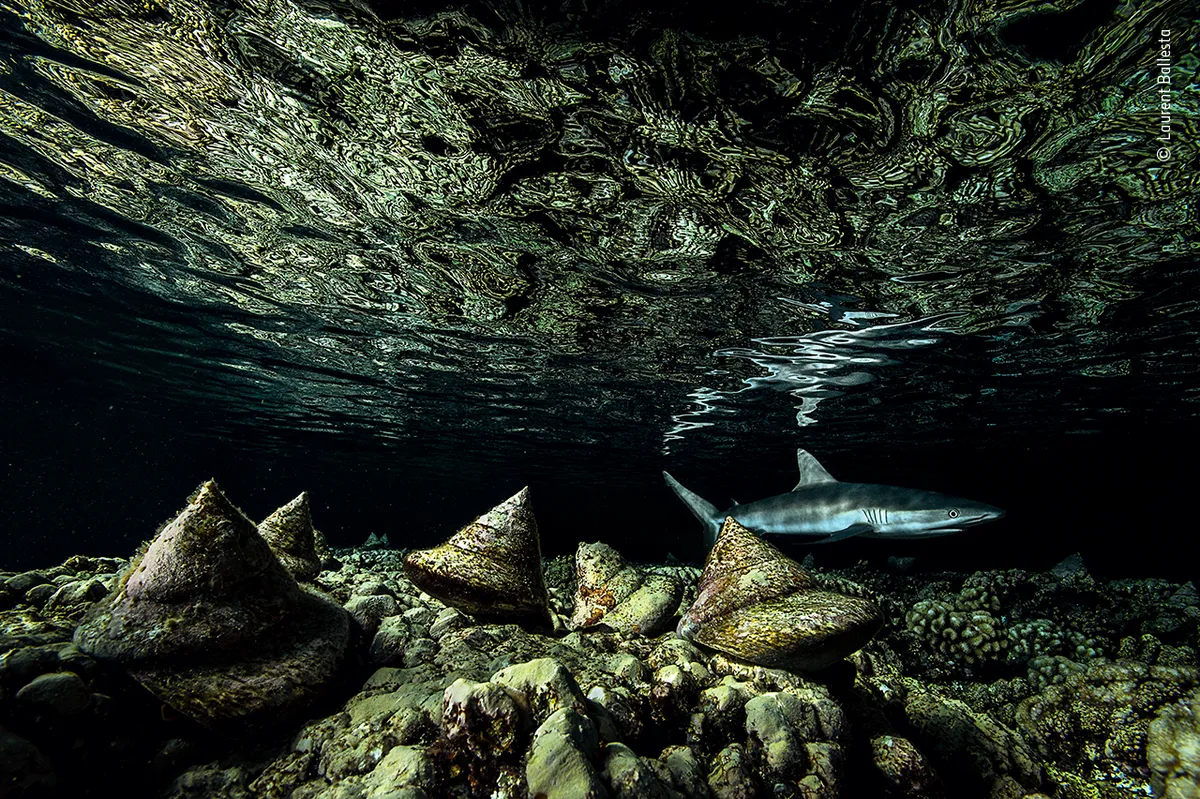
As darkness falls on the remote coral Fakarava Atoll, in French Polynesia, the molluscs begin to move. These large topshells – reaching 15 centimetres (6 inches) across the base – spend the day hiding in crevices among corals, usually on the outer fringes of the reef, withstanding the strong currents and surf.
At night, they emerge to graze on algal pavements and coral rubble. Their thick, cone-shaped shells, shown encrusted with algae, were so sought after – to make mother-of-pearl buttons, jewellery and other handicrafts – that the species was once the world’s most traded invertebrate.
This led to its widespread decline, and it is now the focus of conservation efforts. Cruising behind these slow grazers is one of the reef’s top predators – a grey reef shark, nearly 2 metres (6½ feet) long – capable of speeds of nearly 50 kilometres (30 miles) per hour and ready for a night’s hunting.
It pinpoints prey (mostly bony reef fish) with its acute senses and often hunts in packs. Using a wide angle, Laurent framed the night life stirring beneath the reflections of the reef, contrasting the close-up, angular topshells with the sleek predator behind.
Wildlife Photojournalism: Single Image
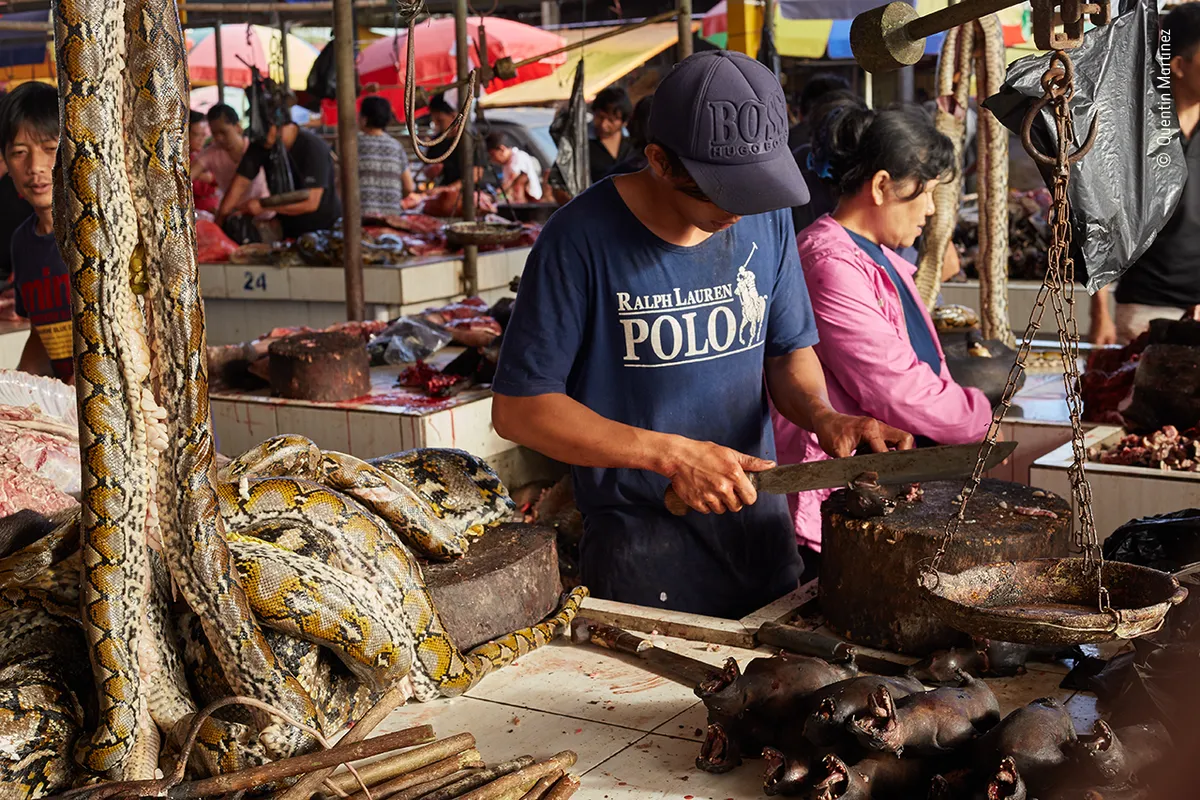
A market trader slicing up fruit bats is surrounded by his other wildlife wares: pythons to his right, with bamboo-skewered ‘bush’ rats beneath them. This is Tomohon Market in northern Sulawesi, Indonesia. Local hunters and traders bring wild mammals and reptiles for sale here, along with domestic cats and dogs – some dead, others alive, to be killed and butchered on site.
Quentin observed the reality of the bushmeat trade, with wild animals in poor condition kept alive, tied to ropes or piled up in cages, awaiting butchery. He was struck by the juxtaposition of contrasting economies: the name-brand clothes of the stallholders amid the wild-animal body parts.
The variety of bushmeat on sale here – which at one time included that of endangered primates – has put Tomohon, billed as an ‘extreme’ food market, on the tourist trail. Since the arrival of Covid-19, suspected to have originated in a food market in China, there have been calls to ban the sale and butchery of live wild animals in Indonesia. Where many different species are confined together in inhumane and unhygienic conditions and then butchered on the same surfaces, there is a perfect opportunity for viruses to cross species barriers.
But being informal, such markets are difficult to regulate. The United Nations has, however, warned that most emerging infectious diseases originate from the wild and that ‘as we continue to relentlessly encroach on nature and degrade ecosystems, we endanger human health’. At the very least, scientists are calling for the separation of wild animals from farmed animals in markets, together with a crackdown on the massive worldwide illegal trade in wildlife.
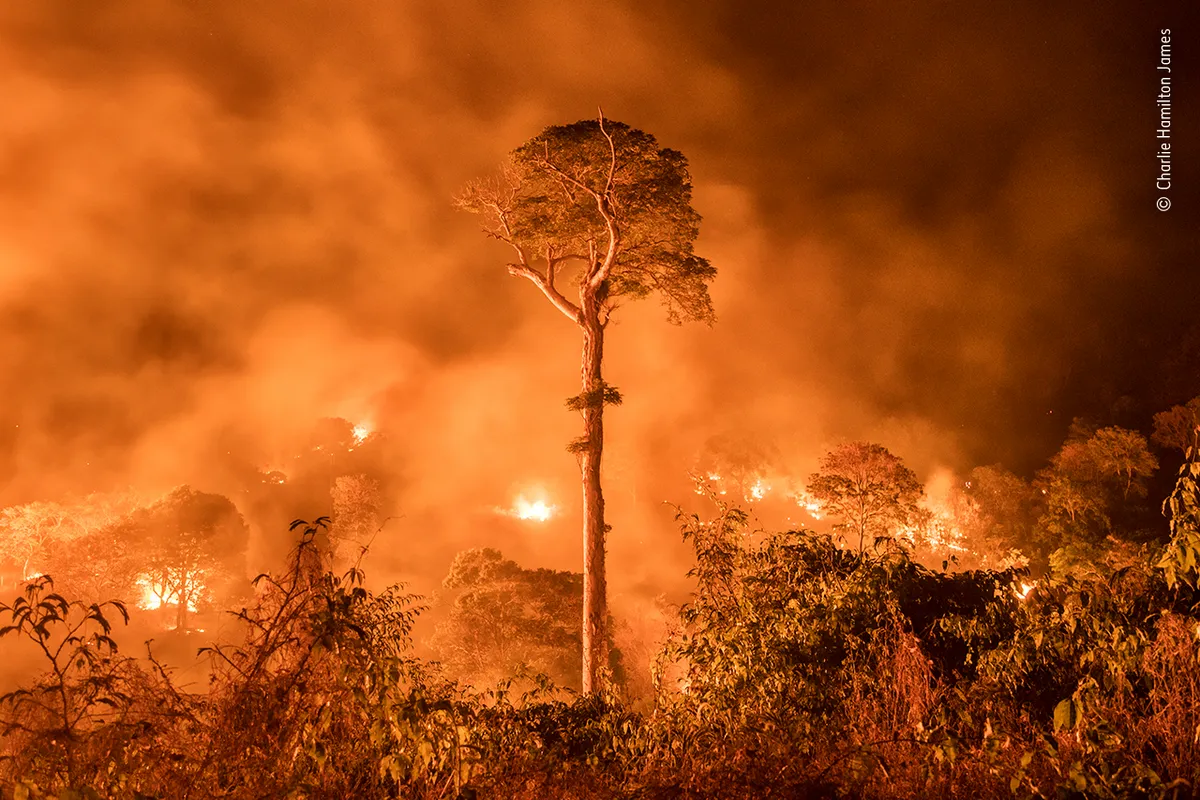
A fire burns out of control in Maranhão state, northeastern Brazil. A single tree remains standing – ‘a monument to human stupidity’, says Charlie, who has been covering deforestation in the Amazon for the past decade. The fire would have been started deliberately to clear a logged area of secondary forest for agriculture or cattle farming.
In 2015, more than half the state’s primary forest was destroyed by fires started by illegal logging on indigenous land. Burning has continued in the state, exacerbated by drought, as land has been cleared, legally and illegally. In the past year, invasion of indigenous reserves and conservation areas by loggers and land-grabbing ranchers has increased, emboldened by President Jair Bolsonaro’s commitment to open up the Amazon for business and his attacks on indigenous groups.
The group most imperilled in the state are the Awá. Just a few hundred Awá remain “in a pocket of forest amid devastation”, says Charlie. Deforestation doesn’t just cause destruction of biodiversity and the loss of the livelihoods of the people who depend on it. Burning trees means losing their oxygen output and letting back into the atmosphere the carbon they have sequestered.
Then cattle brought onto the cleared land add to the greenhouse gases. In 2020, there have been record levels of deforestation in the Amazon, with illegal loggers emboldened by a lack of law enforcement and with cattle ranching fuelled by the global demand for beef.
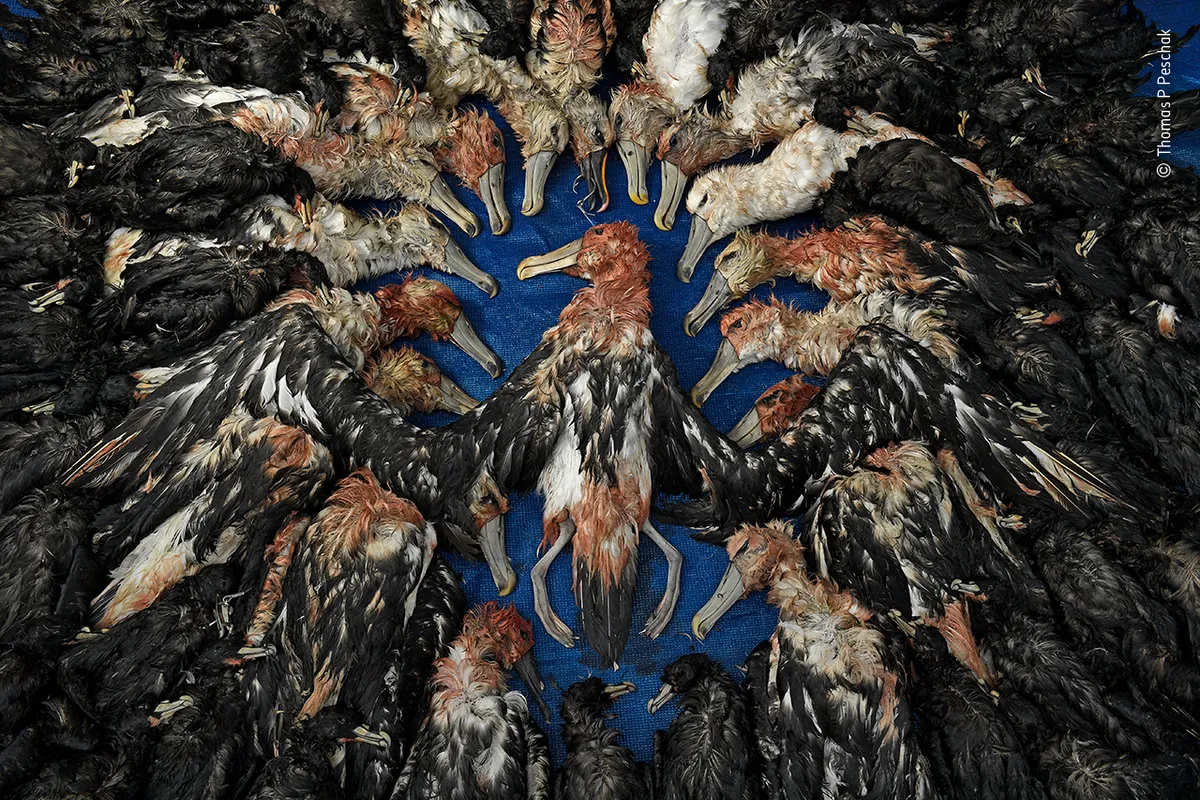
Unlikely as it seems, this display illustrates a South African conservation success story. It represents the comparatively smaller number of deaths of seabirds – here shy albatrosses and a yellow-nosed albatross (a longline hook still in its bill) and white‑chinned petrels – caught in 2017 on longlines set by Japanese tuna-fishing boats off South Africa’s coast.
A boat’s main line can extend for more than 80 kilometres (50 miles), with thousands of baited hooks. When small seabirds dive down and bring the baited hooks to the surface, petrels and albatrosses try to swipe their catches whole, hook themselves and drown.
In recent years, more seabird‑friendly fishing practices – setting lines after dark, using weighted hooks that sink more quickly, dragging bird-scaring lines – have dramatically reduced the annual bird bycatch off South Africa, now numbering in the hundreds instead of tens of thousands. But worldwide, every year, more than 300,000 seabirds, including 100,000 albatrosses, are still killed elsewhere by longlines alone.

As twilight falls on the Alberta tar sands, the stripped landscape takes on an oily blue tint. This vast expanse – once boreal forest – is just one section of the Mildred Lake Tar Mine, itself just one of the region’s many tar mines that together form the world’s third largest oil reserve. But the low-grade tarry oil – bitumen – is obtained by strip-mining the shallow layer of sand, clay and bitumen and then extracting the bitumen using energy‑intensive and potentially chemically polluting processes.
To convey the scale of the operations, Garth chartered a plane and flew over the desolate landscape, choosing the early evening light for contrast and mood. The trucks in the foreground are the height of a two-storey house but are dwarfed by the giant open pit behind. The terraced strips lead towards a refinery – fronted by enormous yellow sulphur piles – and the Athabasca River beyond. All around the pit are tailings waste ponds, which contain a slurry so toxic that birds have to be prevented from landing on them.
Currently, most of the bitumen is shipped, diluted, by pipeline to refineries in the US for processing. The environmental impact of the whole operation is three-fold. First, the mines are created by clearing boreal forest, a rich ecosystem and a vitally important terrestrial carbon sink. Second, the process of extracting the low-grade oil is hugely energy intensive and, according to the region’s First Nation indigenous people, continues to pollute. Third, fully exploiting this massive emissions‑intensive fuel source will result in the further release of huge amounts of carbon that will, say climate scientists, contribute disproportionately to global emissions and make it impossible to keep under the 2°C global warming threshold and avoid catastrophic climate change.
Urban Wildlife
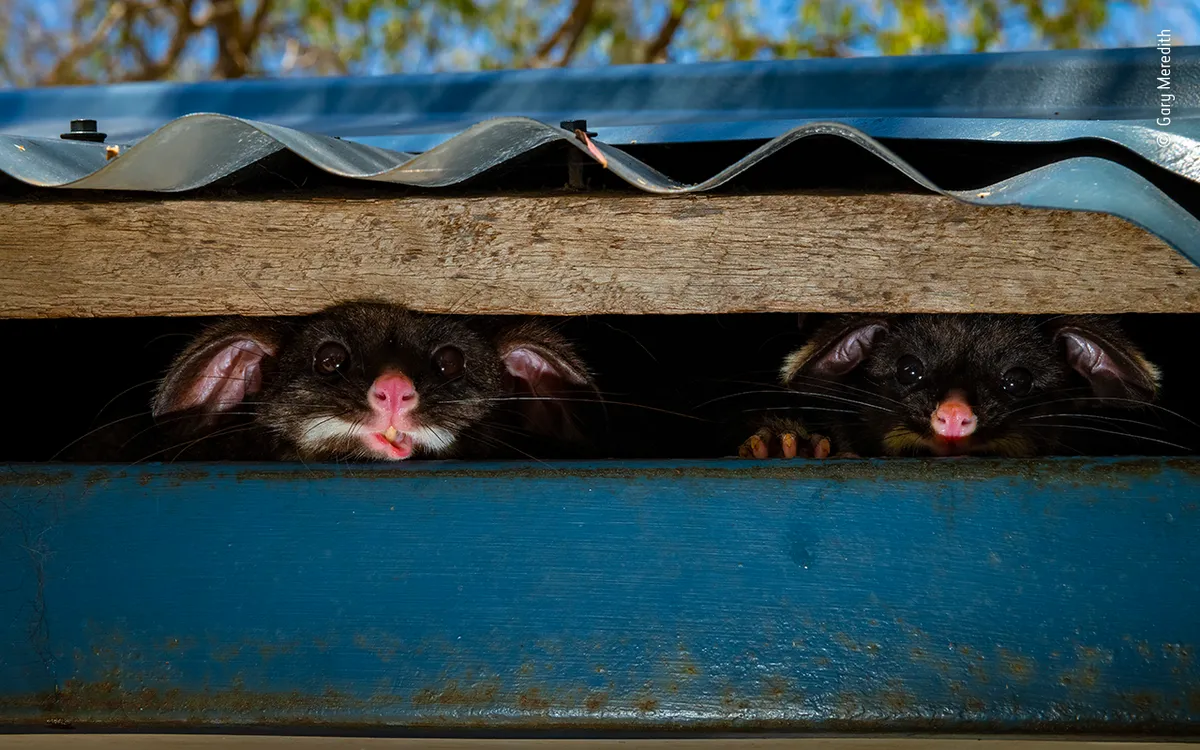
Two common brushtail possums – a mother (left) and her joey – peek out of their hiding place under the roof of a shower block in a holiday park in Yallingup, Western Australia. Gary had watched them all week. They would pop up at sunset, keep an eye on the campers till dark, then squeeze out through the gap and head for the trees to feed on the leaves of a peppermint tree.
These small, adaptable marsupials (mammals with pouches) naturally occur in Australia’s forests and woodlands, taking shelter in tree hollows, but in more urban areas, they may use roof spaces.
To get the right angle, Gary moved his car close to the building and climbed up. The curious possums – probably used to being fed by other campers – stuck their heads out and peered at the interesting man and his camera. He quickly framed their little faces beneath the corrugated iron roof, capturing a sense of their vulnerability, along with their resourcefulness.
15-17 years old
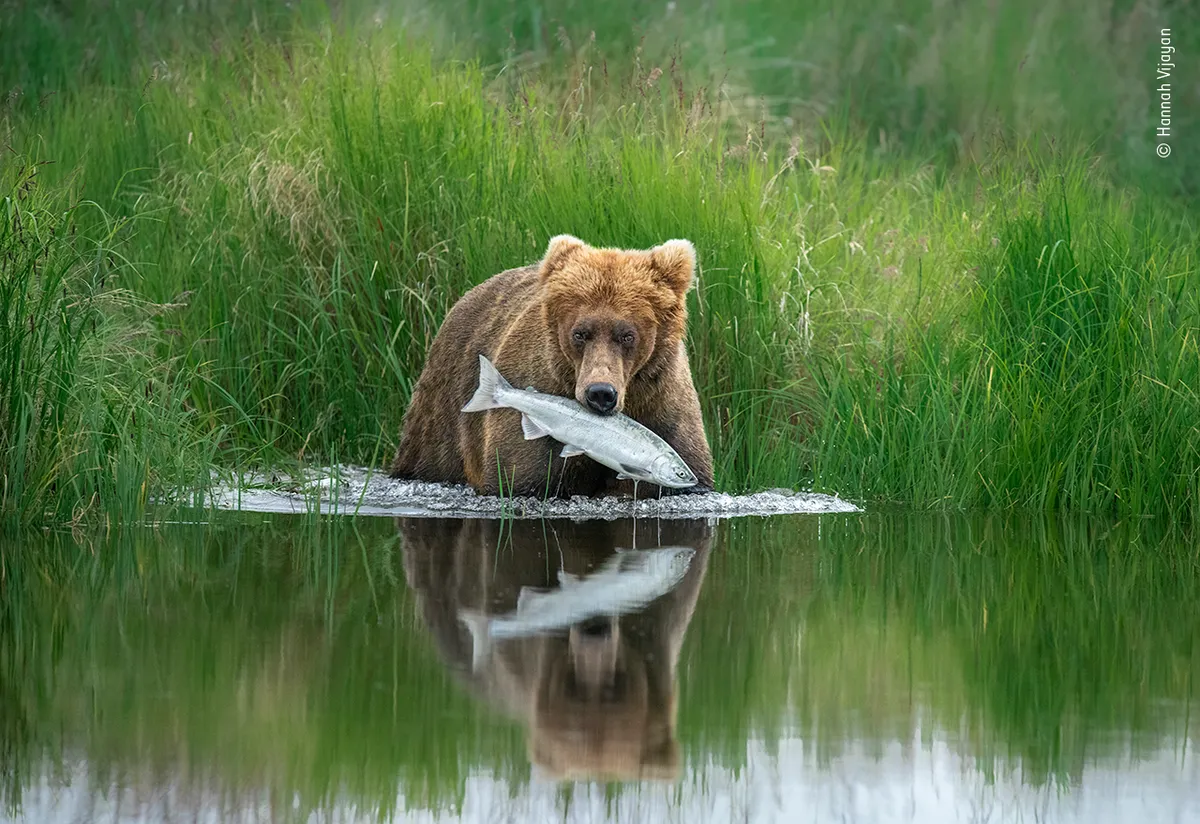
A brown bear pulls a salmon from the shallows of a river in Alaska’s Katmai National Park. The huge park contains Pacific coastline, mountains, lakes, rivers and an estimated 2,200 brown bears. In spring, when bears emerge from hibernation in their mountain dens, many of them head down to feed on sedges in open meadows and forage for clams on the mudflats.
Then they feast on the vast numbers of nutrient-rich sockeye salmon that start arriving, gathering in the estuaries before heading upstream to spawn. Here, the bear has caught a sockeye still in its ocean form (before it has developed its reproductive red colour and pronounced jaws). The presence of the salmon through until autumn ensures the bears’ survival through the winter. Alaskan brown bears are among the world’s largest. Males may eat 30 salmon a day and weigh more than 450 kilograms (1,000 pounds) by the end of the summer. Females are smaller and typically weigh a third less.
The greatest concentration of bears – and of tourists – is around the waterfall at Brooks River, where viewing platforms enable visitors to watch bears catching salmon leaping up the falls. Hannah chose to focus on a quieter scene and a different style of fishing. Instead of snatching at leaping fish or jumping on them, this female put her head under the water to look for one. Hannah had been watching for some time before she achieved the composition she wanted: a full reflection of the bear – and its catch – in still water.
11-14 years old
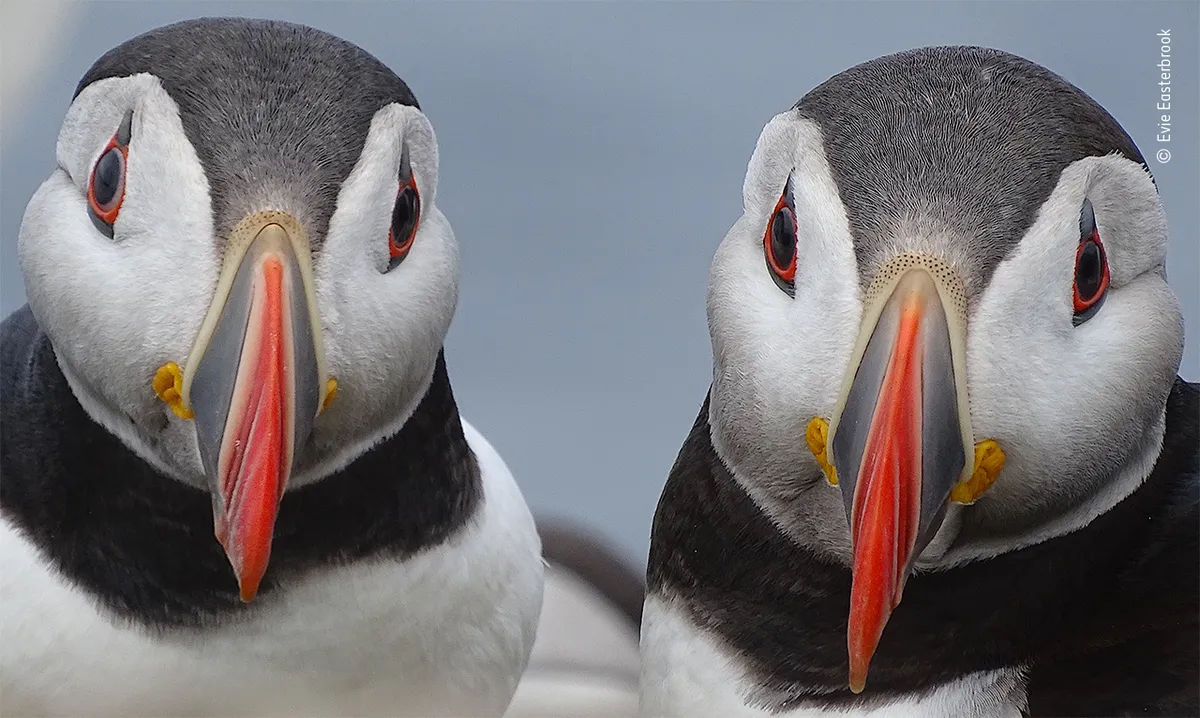
A pair of Atlantic puffins in vibrant breeding plumage pause near their nest burrow on the Farne Islands. Every spring, these small islands off Northumberland attract more than 100,000 breeding pairs of seabirds. While guillemots, razorbills, kittiwakes and fulmars crowd onto the cliffs, puffins nest in burrows on the grassy slopes above.
When wintering at sea, their plumage is a dull black and grey, but by the time they return to breed, they are sporting black ‘eye liner’ and brightly coloured bill plates that have fused into an unmistakable beak – one which, to other puffins, also glows with UV light.
Evie had longed to see a puffin, and when school broke up, she and her family managed two day trips to Staple Island in July, before the puffins returned to sea in August. She stayed by the puffins’ burrows, watching the adults returning with mouthfuls of sand eels.
Puffins are long-lived and form long-term pairs, and Evie concentrated on this pair, aiming for a characterful portrait. Puffins worldwide are in decline, vulnerable to the effects of climate disruption, including more frequent storms and warmer water, which has reduced the availability of sand eels, their staple food.
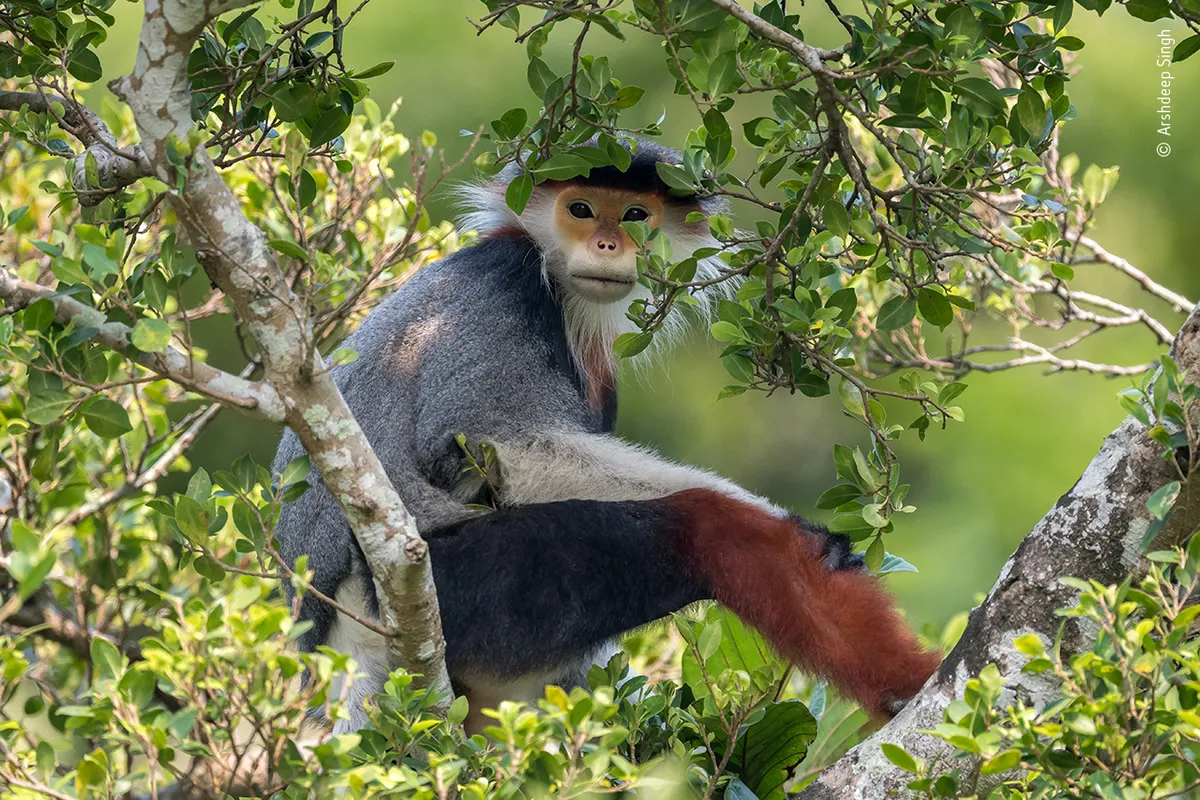
When his father planned a business trip to Vietnam, Arshdeep researched the wildlife online. It was after he read about the endangered red-shanked douc langur that he asked his father to take him along. The meeting was near Son Tra Nature Reserve, Vietnam’s last coastal rainforest and a stronghold for the langur.
Found only in Vietnam, Laos and Cambodia, the primate is threatened by habitat loss, hunting and trade. Douc langurs eat mostly leaves, seeds, flowers and fruit and live in the canopy – a challenge for a photographer. Arshdeep had just three days at Son Tra. The first was hot, and the doucs were in the shade.
On the next day, his long wait was rewarded when a male appeared in a tree on the slope opposite. It was a struggle to hold his telephoto lens steady and shoot at an angle clear of leaves, and just for a second, the langur glanced at him – the moment Arshdeep had come to Vietnam for.